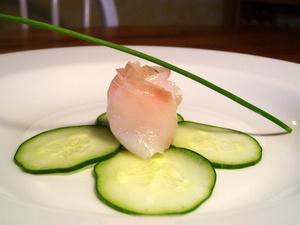
Carolyn from 18th Century Cuisine is hosting "Cooking the old fashioned way - AKA Disaster Preparedness" event. Who says you need electricity and gas to cook? Salt will do in a pinch. I know this does not exactly look like a disaster preparedness type of dish, but if you ignore the fancy presentation, it's quite practical. Gravlax is Swedish cured salmon. Although no heating method is involved, the fish is "cooked" or preserved with salt and sugar. I didn't use as much salt as traditional Gravlax since I was planning to store the fish in the fridge and consume it in a few days, but in case of a real disaster, it would stay just fine without refrigeration if more salt was used for the cure.
Inspired by Stephen's post (from stephencooks.com) about "Gravblue," bluefish cured gravlax style, I decided to try it with sweet and buttery sable (also known as black cod or butterfish). It turned out incredibly well, but I am not sure if I'd pay $15/Lb for sable next time, when salmon tastes as good for $10/Lb.

Once I was done with picture taking, I chucked the fancy presentation in favor of a good sandwich with cucumbers, sprouts, and guacamole.
2 identical center cut salmon fillets with the skin (2 Lb total)
1 Tbsp black pepper corns
1/4 cup sea or kosher salt
2 Tbsp sugar
1 Tbsp cognac
1/2 cup coarsely chopped dill
- Remove any pin bones from salmon with needlenose pliers or tweezers.
- Put pepper corns into a small ziploc bag and crush by rolling them with a rolling pin or pressing on them with a heavy skillet.
- Mix salt, sugar, and crushed pepper corns.
- Rub both sides of fillets heavily with about half of the salt and sugar mixture. Sprinkle the remaining salt and sugar onto the flesh side of fillets. Sprinkle with cognac. Spread dill evenly over one fillet.
- Place the second fillet on top of the first one so that the flesh side of fillets is together, and the skin is outside. You should end up with a salmon dill sandwich. Place it in a large freezer ziploc bag, get as much air out as possible, and lock the bag.
- Put the bag with salmon in a pyrex or other shallow baking dish, place a cutting board, and then a heavy weight (5-8 Lb) on top of salmon. I use an old brick wrapped in foil.
- Refrigerate for 2 days turning the bag with salmon over every 12 hours.
- After 2 days, get the salmon out of the bag, rinse under cold water and dry with paper towels. Slice very thinly at 45 degree angle and serve.
Gravlax will keep in the fridge for 4-5 days, or you can freeze it for couple of months.

6 comments:
I love both pictures, really. I've been planning to make gravlax for the longest time but it's hard not to eat good fresh fish when you bring it home from the store.
I'm wondering about the alcohol in these cures. Some call for vodka or aquavit and I see you used cognac. Is it essential for the cure or is it a flavor thing? Does it matter what kind you use?
Some recipes don't call for any alcohol at all (I've tried it and it works fine). It's not needed to cure the fish (salt and sugar do that), so it's just a flavor thing. I usually use cognac, but I am sure it works with vodka, wiskey, aquavit, etc.
I sometime cure salmon at home (Riga), where it is wonderfully cheap. I use salt and sugar, and pepper and lemon zest for flavor, and sometimes just leave the whole thing to cure out of the fridge for a couple of hours. It works much faster, and I tend to be impatient with tasty things =)
Stephen and your posts are very inspiring. How'd you get the chive(?) to stand like that?
Paz
Hi Paz,
Chives are very light, so if you just lean them against your food, they'll stay there. Of course, if you are going to move that plate, the chive might fall, so it's better to put the plate in its final destination and then add the chive. For more sticky food, like risotto, it's much easier to get the chive to stay there and you can move the plate without any problems.
Ahhh! I've learned something new! Love it! Thanks, Helen!
Best,
Paz
Post a Comment